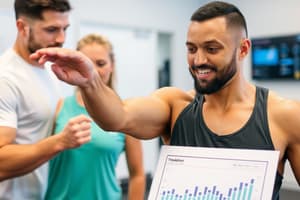Podcast
Questions and Answers
What does the PACER test measure?
What does the PACER test measure?
- Body composition
- Muscle strength
- Flexibility
- Endurance (correct)
How is the success in the push-up test determined?
How is the success in the push-up test determined?
- Based on height reached
- Based on balance
- Based on speed
- Based on proper form and full elbow extensions (correct)
Which equipment can students use to input data for analysis in mobile apps related to fitness goals?
Which equipment can students use to input data for analysis in mobile apps related to fitness goals?
- Thermometers
- Altimeters (correct)
- Weighing scales
- Blood pressure monitors
What do wearable devices like Fitbits and Apple Watches track?
What do wearable devices like Fitbits and Apple Watches track?
How do bioelectrical impedance analysis (BIA) measurements help in assessing body composition?
How do bioelectrical impedance analysis (BIA) measurements help in assessing body composition?
What is an advantage of incorporating self-assessment activities in physical education?
What is an advantage of incorporating self-assessment activities in physical education?
What is the main goal of self-testing activities in physical education?
What is the main goal of self-testing activities in physical education?
Why are self-monitoring and tracking tools important in physical education?
Why are self-monitoring and tracking tools important in physical education?
What is the purpose of fitness testing protocols in physical education settings?
What is the purpose of fitness testing protocols in physical education settings?
Why are aerobic capacity tests important in physical education?
Why are aerobic capacity tests important in physical education?
How do fitness tests impact teachers' lesson planning?
How do fitness tests impact teachers' lesson planning?
In what way do self-testing activities empower individuals in physical education?
In what way do self-testing activities empower individuals in physical education?
Flashcards are hidden until you start studying
Study Notes
Self-Testing Activities in Physical Education: Fitness Testing Protocols
In the realm of physical education, self-testing is more important now than ever before due to increased accessibility to technology and information. While traditional large group tests can still have their place, self-monitoring and tracking tools allow students to learn more effectively through personalized feedback. This approach enables individuals to take control of their own learning journey by monitoring their progress in real time with the goal to gradually increase their performance over time. In this context, we will focus on the different types of fitness testing protocols used in physical education settings.
Types of Fitness Tests
There are three main categories of fitness tests commonly used in schools to assess students' level of fitness: aerobic capacity, muscular strength, and flexibility. These tests help teachers determine where each student stands academically, physically, and socially within these domains, which ultimately affects how the teacher plans future lessons.
Aerobic Capacity Tests
Aerobic capacity tests evaluate the body's ability to transport oxygen and deliver it to working muscles during exercise. Some common tests include:
- The PACER test: Also known as the Progressive Aerobic Cardiovascular Endurance Run (PACER), this test measures endurance by having participants run back and forth between two lines marked 20 meters apart while maintaining a target speed until they cannot continue without pausing longer than prescribed.
Musculoskeletal Strength Tests
Muscle strength tests measure force production across joints when using specific muscle groups. For example:
- The push-up test: Participants perform standardized pushups, recording successes based on proper form and counting only full elbow extensions.
Body Composition Measurements
Body composition measurements reveal the percentage of fat and lean mass within the human body. Common methods include skinfold calipers and bioelectrical impedance analysis (BIA).
Using Technology for Student Feedback
Technology offers new ways for students to track their progress and receive immediate feedback. Some examples are:
-
Mobile apps: Students can input data from various sources including heart rate monitors, accelerometers, gyroscopes, magnetometers, and altimeters found in smartphones to analyze movements and map behaviors related to personal fitness goals.
-
Wearable devices: Trackers such as Fitbits and Apple Watches record steps taken daily and monitor sleep patterns, providing users with insights into overall health trends.
These technologies empower students to make informed decisions about their wellness objectives, encouraging them towards lifelong healthy habits. However, educators need to balance the benefits of individualized attention against potential negative impacts like reduced face-to-face interaction. Ultimately, integrating technological advances in the classroom requires careful planning and consideration of both pedagogical values and practical concerns.
In conclusion, self-assessment activities in physical education offer significant advantages, allowing students to improve upon areas of weakness and capitalize on strengths, thus enhancing their overall fitness levels. By incorporating a variety of assessment techniques and utilizing cutting-edge technology, educators can ensure that these experiences remain relevant and engaging.
Studying That Suits You
Use AI to generate personalized quizzes and flashcards to suit your learning preferences.




